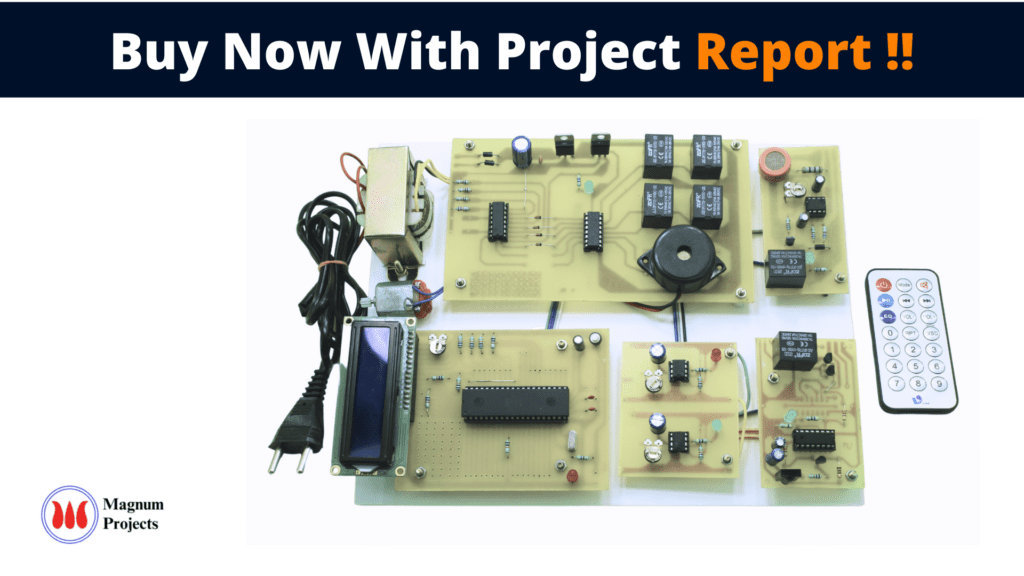Table of Contents
Introduction:

Driving while either intoxicated or drunk is dangerous and drivers with high blood alcohol content (BAC) are at increased risk of car accidents, highway injuries, and vehicular deaths. Prevention measures evaluated include license suspension or revocation, impounding or confiscating vehicle plates, enforcing open container bans, increasing fine penalties, jail, mandating education for youth, and lowering legal BACs.
Even though they’re many hurdles created by authorities to drunken driving, it is continuing like serial episodes. As such there is no effective mechanism to prevent this. Here, we have planned to design an Automatic Alcohol Detector, which is integrated with the steering wheel. Ethanol has more capacity to absorb IR rays. So, we use IR rays Sensor which is mounted on the steering. An IR cell directs IR Energy through the sample and any unabsorbed energy on the other side is detected. The higher the concentration of ethanol, the more infrared absorption occurs (in the same way that a cooler absorbs visible light, alcohol absorbs infrared light). Thus the alcohol level of the driver is continuously monitored and calibrated on a scale. When it exceeds a particular limit the fuel supply is cut off. If the device is removed also, the fuel supply will be automatically cut off or an alarm is triggered depending upon the requirement. This doesn’t happen abruptly. Special indicators are fixed at the back to avoid inconvenience to other drivers using that Lane.
Further, in this paper, we have designed a mechanical system for controlling the speed of vehicles in densely populated regions. Advanced digital maps have the capacity for real-time updates duly, including information on areas, where speed limits should be reduced due to adverse weather conditions or around accident scenes, road-works. This paper also discusses the onboard vision system by evaluating the surroundings of the vehicles and thereby improving the safety and efficiency of driving. It depends on an important ability of various recognitions like traffic signals, signs, and pedestrians and frameworks an integration of sensors and control modules in a scalable multi-agent system.

Block diagram explanation
Power supply unit
This section needs two voltages viz., +12 V & +5 V, as working voltages. Hence specially designed power supply is constructed to get regulated power supplies.
RF transmitter
RF transmitters are electronic devices that create continuously varying electric currents, encode sine waves, and broadcast radio waves. RF transmitters use oscillators to create sine waves, the simplest and smoothest form of continuously varying waves, which contain information such as audio and video. Modulators encode these sign wives and antennas broadcast them as radio signals. There are several ways to encode or modulate this information, including amplitude modulation (AM) and frequency modulation (FM). Radio techniques limit localized interference and noise.
RF receiver
RF receivers are electronic devices that separate radio signals from one another and convert specific signals into audio, video, or data formats. RF receivers use an antenna to receive transmitted radio signals and a tuner to separate a specific signal from all of the other signals that the antenna receives. Detectors or demodulators then extract information that was encoded before transmission. There are several ways to decode or modulate this information, including amplitude modulation (AM) and frequency modulation (FM). Radio techniques limit localized interference and noise.
Buffers
Buffers do not affect the logical state of a digital signal (i.e. a logic 1 input results in a logic 1 output whereas logic 0 input results in a logic 0 output). Buffers are normally used to provide extra current drive at the output but can also be used to regularize the logic present at an interface
Drivers
This section is used to drive the relay where the output is the complement of input which is applied to the drive but the current will be amplified
Relays
It is an electromagnetic device that is used to drive the load connected across the relay and the o/p of the relay can be connected to the controller or load for further processing.
Buzzer:
A buzzer or beeper is an audio signaling device, which may be mechanical, electromechanical, or piezoelectric. Typical uses of buzzers and beepers include alarm devices, timers, and confirmation of user input such as a mouse click or keystroke.
DC motor:
A DC motor relies on the fact that magnet poles repel and unlike magnetic poles attract each other. A coil of wire with a current running through it generates an electromagnetic field aligned with the center of the coil. By switching the current on or off in a coil its magnetic field can be switched on or off or by switching the direction of the current in the coil the direction of the generated magnetic field can be switched 180°.
Methodology:
The main objective of this project is to provide an alert for the driver if the driver feels drowsy and if he has drunk. The IR Transmitter and Receiver are introduced in the project to detect drowsiness. If drowsiness is detected then this module will activate the motor to produce vibration via monostable multivibrator and Microcontroller. Like if the driver has drunk then the Alcohol detector senses alcoholic content in the driver and locks the vehicle by deactivating the motor. Buzzer will be ON for both the cases
Advantages:
- This circuit detects the alcohol directly
- This circuit is simple in construction.
- Readily available ICs are used.
- Responsibility for the circuit is high.
- High Accuracy.
- The advantage of the system is that the driver cannot even tamper with it. Because the fuel supply valve is open only when all the components are working properly and the IR light detected is comparable to the standard value.
Disadvantages:
- The sensor circuit senses the particular amount of alcohol content.
Applications:
- All car owners.
- Drivers.
- Travels Operators.




